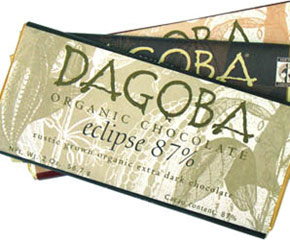Chocolate is the largest growing snack segment in the US organic market, according to an industry study, with organic sales tallying a 49 percent increase in sales in 2006.
Organic chocolate sales totalled a $70.8 million fraction of the market, according to a Euromonitor report cited by the Dagoba Organic Chocolate company, compared with total US chocolate sales in 2006 of about $6 billion.
The average American consumes about 12 pounds of chocolate per year, said Cathy Strange, global chocolate buyer for Whole Foods Market Inc., which sells organic brands like Dagoba, Green & Black’s, Lake Champlain, Chocolove and Newman’s Own.
Organic chocolate is made from cocoa grown without pesticides and herbicides. Producers use certified organic sugar, essential oils, fruits, and nuts in accordance with USDA organic regulations.
In the chocolate market, as in other food areas, education about issues like sustainability and fair trade, as well as product quality, has evolved.
Big-name companies are responding to the trend. In May 2005, Cadbury Schweppes Plc acquired the Green & Black’s brand, and Hershey Co. bought Dagoba in October 2006, both for undisclosed amounts.
Russell Stover, known for selling boxes of chocolate in drugstores, has even entered the game, with its new organic Belgian milk and 60 percent solid dark organic chocolate going on sale at Target Corp. stores.
But while organics are often associated with health, chocolate is seen as an indulgence. Organic chocolate, like most other organic foods, generally costs at least $1 more per bar (49.6 g) than its non-organic counterparts. A non-organic bar of the same size can cost less than $1.
“Natural food consumers are demanding it,” said Katrina Markoff, founder of Vosges Haut Chocolat, a Chicago-based boutique chocolatier. “Amongst certain groups, this is a no-brainer.”
Markoff’s Chicago production facility was recently certified as organic. She hopes for 80 percent of her product line to be organic by the end of 2008.
Organic chocolate has become viable not only for small, artisan producers but for mass marketers as well.

